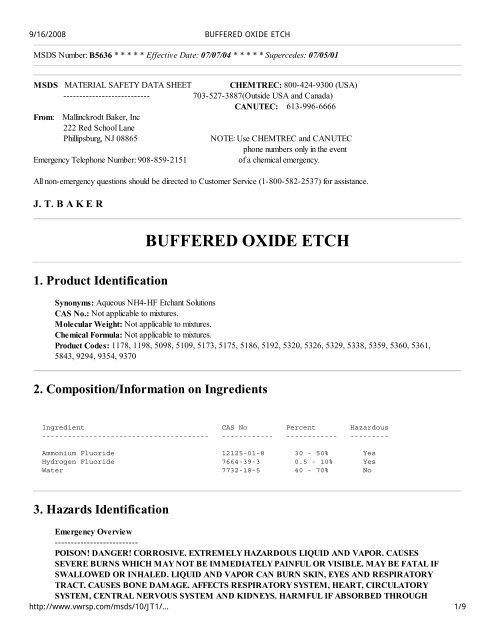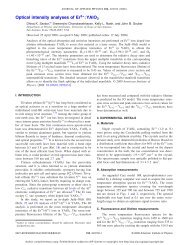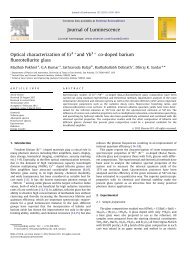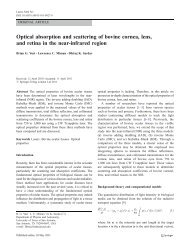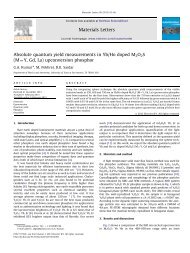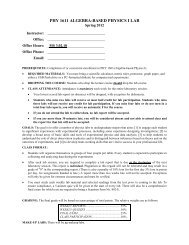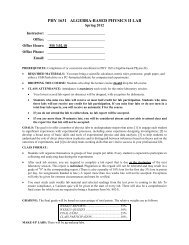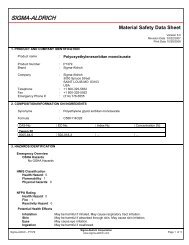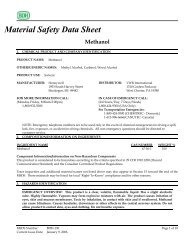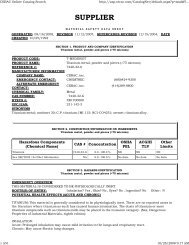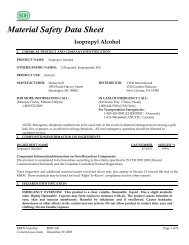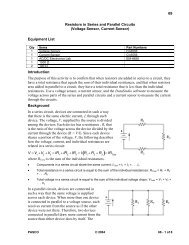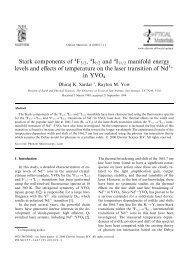Create successful ePaper yourself
Turn your PDF publications into a flip-book with our unique Google optimized e-Paper software.
9/16/2008 <strong>BUFFERED</strong> <strong>OXIDE</strong> <strong>ETCH</strong><br />
MSDS Number: B5636 * * * * * Effective Date: 07/07/04 * * * * * Supercedes: 07/05/01<br />
MSDS MATERIAL SAFETY DATA SHEET CHEMTREC: 800-424-9300 (USA)<br />
--------------------------- 703-527-3887(Outside USA and Canada)<br />
CANUTEC: 613-996-6666<br />
From: Mallinckrodt Baker, Inc<br />
222 Red School Lane<br />
Phillipsburg, NJ 08865 NOTE: Use CHEMTREC and CANUTEC<br />
phone numbers only in the event<br />
Emergency Telephone Number: 908-859-2151 of a chemical emergency.<br />
All non-emergency questions should be directed to Customer Service (1-800-582-2537) for assistance.<br />
J. T. B A K E R<br />
1. Product Identification<br />
<strong>BUFFERED</strong> <strong>OXIDE</strong> <strong>ETCH</strong><br />
Synonyms: Aqueous NH4-HF Etchant Solutions<br />
CAS No.: Not applicable to mixtures.<br />
Molecular Weight: Not applicable to mixtures.<br />
Chemical Formula: Not applicable to mixtures.<br />
Product Codes: 1178, 1198, 5098, 5109, 5173, 5175, 5186, 5192, 5320, 5326, 5329, 5338, 5359, 5360, 5361,<br />
5843, 9294, 9354, 9370<br />
2. Composition/Information on Ingredients<br />
Ingredient CAS No Percent Hazardous<br />
--------------------------------------- ------------ ------------ ---------<br />
Ammonium Fluoride 12125-01-8 30 - 50% Yes<br />
Hydrogen Fluoride 7664-39-3 0.5 - 10% Yes<br />
Water 7732-18-5 40 - 70% No<br />
3. Hazards Identification<br />
Emergency Overview<br />
--------------------------<br />
POISON! DANGER! CORROSIVE. EXTREMELY HAZARDOUS LIQUID AND VAPOR. CAUSES<br />
SEVERE BURNS WHICH MAY NOT BE IMMEDIATELY PAINFUL OR VISIBLE. MAY BE FATAL IF<br />
SWALLOWED OR INHALED. LIQUID AND VAPOR CAN BURN SKIN, EYES AND RESPIRATORY<br />
TRACT. CAUSES BONE DAMAGE. AFFECTS RESPIRATORY SYSTEM, HEART, CIRCULATORY<br />
SYSTEM, CENTRAL NERVOUS SYSTEM AND KIDNEYS. HARMFUL IF ABSORBED THROUGH<br />
http://www.vwrsp.com/msds/10/JT1/… 1/9
9/16/2008 <strong>BUFFERED</strong> <strong>OXIDE</strong> <strong>ETCH</strong><br />
SYSTEM, CENTRAL NERVOUS SYSTEM AND KIDNEYS. HARMFUL IF ABSORBED THROUGH<br />
SKIN. REACTION WITH CERTAIN METALS GENERATES FLAMMABLE AND POTENTIALLY<br />
EXPLOSIVE HYDROGEN GAS.<br />
J.T. Baker SAF-T-DATA (tm) Ratings (Provided here for your convenience)<br />
-----------------------------------------------------------------------------------------------------------<br />
Health Rating: 4 - Extreme (Poison)<br />
Flammability Rating: 0 - None<br />
Reactivity Rating: 2 - Moderate<br />
Contact Rating: 4 - Extreme (Corrosive)<br />
Lab Protective Equip: GOGGLES & SHIELD; LAB COAT & APRON; VENT HOOD; PROPER GLOVES<br />
Storage Color Code: White (Corrosive)<br />
-----------------------------------------------------------------------------------------------------------<br />
Potential Health Effects<br />
----------------------------------<br />
Exposure to hydrofluoric acid can produce harmful health effects that may not be immediately apparent. If inhaled or<br />
swallowed, this compound can cause fluoride poisoning. Early symptoms include nausea, vomiting, diarrhea, and<br />
weakness. Later effects include central nervous system effects, cardiovascular effects and death.<br />
Inhalation:<br />
Severely corrosive to the respiratory tract. May cause sore throat, coughing, labored breathing and lung<br />
congestion/inflammation. May be absorbed through inhalation of vapors. Symptoms parallel those following ingestion<br />
exposure.<br />
Ingestion:<br />
Corrosive. May cause sore throat, abdominal pain, diarrhea, vomiting, severe burns of the digestive tract, kidney<br />
dysfunction and brain damage. Affects the heart and circulatory system.<br />
Skin Contact:<br />
Corrosive to the skin. Skin contact causes serious skin burns which may not be immediately apparent or painful.<br />
Symptoms may be delayed 8 hours or longer. The fluoride ion readily penetrates the skin causing destruction of deep<br />
tissue layers and even bone.<br />
Eye Contact:<br />
Corrosive to the eyes. Symptoms of redness, pain, blurred vision, and permanent eye damage may occur.<br />
Chronic Exposure:<br />
Intake of more than 6 mg of fluorine per day may result in fluorosis, bone and joint damage. Hypocalcemia and<br />
hypomagnesemia can occur from absorption of fluoride ion into blood stream.<br />
Aggravation of Pre-existing Conditions:<br />
Persons with pre-existing skin disorders, eye problems, or impaired kidney or respiratory function may be more<br />
susceptible to the effects of this substance.<br />
4. First Aid Measures<br />
For any route of contact: Detailed First Aid procedure should be planned before beginning work with HF.<br />
Inhalation:<br />
Get medical help immediately. If patient is unconscious, give artificial respiration or use inhalator. Keep patient warm<br />
and resting, and send to hospital after first aid is complete.<br />
Ingestion:<br />
If swallowed, DO NOT INDUCE VOMITING. Give large quantities of water. Never give anything by mouth to an<br />
unconscious person. Get medical attention immediately.<br />
Skin Contact:<br />
http://www.vwrsp.com/msds/10/JT1/… 2/9
9/16/2008 <strong>BUFFERED</strong> <strong>OXIDE</strong> <strong>ETCH</strong><br />
1) Remove the victim from the contaminated area and immediately place him under a safety shower or wash him with a<br />
water hose, whichever is available. 2) Remove all contaminated clothing. Handle all HF-contaminated material with<br />
gloves made of appropriate material, such as PVC or neoprene. 3) Keep washing with large amounts of water for a<br />
minimum of 15 minutes. 4) Have someone make arrangements for medical attention while you continue flushing the<br />
affected area with water. 5) If the following materials are available, limit the washing to five minutes and immerse the<br />
burned area in a solution of 0.2% iced aqueous Hyamine 1622 or 0.13% iced aqueous Zephiran Chloride. If immersion<br />
is not practical, towels should be soaked with one of the above solutions and used as compresses for the burn area.<br />
Ideally compresses should be changed every 2 minutes. Alternately, 2.5% calcium gluconate gel should be massaged<br />
into the affected area. 6) Seek medical attention as soon as possible for all burns regardless of how minor they may<br />
appear initially. Hyamine 1622 is a trade name for tetracaine benzethonium chloride, Merck Index Monograph 1078, a<br />
quaternary ammonium compound sold by Rohm & Haas, Philadelphia. Zephiran Chloride is a trade name for<br />
benzalkonium chloride, Merck Index Monograph 1059, also a quaternary ammonium compound, sold by Sanofi-<br />
Synthelabo Inc., New York, NY.<br />
Eye Contact:<br />
1) Irrigate eyes for at least 30 minutes with copious quantities of water, keeping the eyelids apart and away from<br />
eyeballs during irrigation. 2) Get competent medical attention immediately, preferably an eye specialist. 3) If a physician<br />
is not immediately available, apply one or two drops of ophthalmic anesthetic, (e.g., 0.5% Pontocaine Hydrochloride<br />
solution). 4) Do not use oily drops, ointment or HF skin burn treatments. Place ice pack on eyes until reaching<br />
emergency room.<br />
Note to Physician:<br />
General: For burns of moderate areas, (greater than 8 square inches), ingestion and significant inhalation exposure,<br />
severe systemic effects may occur, and admission to a critical care unit should be considered. Monitor and correct for<br />
hypocalcemia, cardiac arrhythmias, hypomagnesemia and hyperkalemia. In some cases renal dialysis may be indicated.<br />
Inhalation: Treat as chemical pneumonia. Monitor for hypocalcemia, 2.5% calcium gluconate in normal saline by<br />
nebulizer or by IPPB with 100% oxygen may decrease pulmonary damage. Bronchodilators may also be administered.<br />
Skin: For deep skin burns or contact with concentrated HF (over 50%) solution, consider infiltration about the affected<br />
area with 5% calcium gluconate [equal parts of 10% calcium gluconate and sterile saline for injection]. Burns beneath<br />
the nail may require splitting the nail and application of calcium gluconate to the exposed nail bed. For certain burns,<br />
especially of the digits, use of intra-arterial calcium gluconate may be indicated.<br />
Eyes: Irrigation may be facilitated by use of Morgan lens or similar ocular irrigator, using 1% aqueous calcium gluconate<br />
solution [50ml of calcium gluconate 10% in 500 ml normal saline].<br />
AN ALTERNATIVE FIRST AID PROCEDURE: The effect of HF, i.e. onset of pain, particularly in dilute solutions,<br />
may not be felt for up to 24 hours. It is important, therefore, that persons using HF have immediate access to an<br />
effective antidote even when they are away from their work place in order that first aid treatment can be commenced<br />
immediately.<br />
We recommend that any person in contact with HF should carry, or have access to a tube of HF Antidote Gel at all<br />
times; ideally with one tube at the work place, one on the person and one at home.<br />
It is imperative that any person who has been contaminated by HF should seek medical advice when the treatment by<br />
HF Antidote Gel has been applied.<br />
REFERENCES: 1. Browno, T.D. Treatment of Hydrofluoric Acid Burns 2. Sprout, W.L. et al Treatment of Severe<br />
Hydrofluoric Acid Exposures (Journal of American Occupational Medicine 25:12, 1993) 3. Bracken, W.M. et al<br />
Comparative Effectiveness of Topical Treatments for Hydrofluoric Acid Burns, University of Kansas (Journal of<br />
Occupational Medicine 27:10:1985) 4. Burke, W.J. , et al Systemic Fluoride Poisoning Resulting from A Fluoride Skin<br />
Burn (Journal of Occupational Medicine (5,39:1973)<br />
HF ANTIDOTE GEL:<br />
Distributed by Pharmascience Inc.<br />
http://www.vwrsp.com/msds/10/JT1/… 3/9
9/16/2008 <strong>BUFFERED</strong> <strong>OXIDE</strong> <strong>ETCH</strong><br />
8400 Darnley Rd. Montreal, Canada. H4T 1M4<br />
Phone: ( 514 ) 340 - 1114<br />
Fax: ( 514 ) 342 - 7764<br />
U.S. (Buffalo, NY) distributor: 1-800-207-4477<br />
5. Fire Fighting Measures<br />
Fire:<br />
Not considered to be a fire hazard. If involved in a fire, can emit toxic fumes and irritating and corrosive gases.<br />
Explosion:<br />
Violent exothermic reaction occurs with water. Sufficient heat may be produced to ignite combustible materials. Reacts<br />
with metals forming flammable Hydrogen gas.<br />
Fire Extinguishing Media:<br />
Keep upwind of fire. Use water or carbon dioxide on fires in which Hydrofluoric Acid is involved. Halon or foam may<br />
also be used. In case of fire, the sealed containers can be kept cool by spraying with water.<br />
Special Information:<br />
In the event of a fire, wear full protective clothing and NIOSH-approved self-contained breathing apparatus with full<br />
facepiece operated in the pressure demand or other positive pressure mode. Avoid getting water in tanks or drums;<br />
water can cause generation of heat and spattering. In contact with air, the acid gives off corrosive fumes which are<br />
heavier than air.<br />
6. Accidental Release Measures<br />
Notify safety personnel, provide adequate ventilation, and remove ignition sources since hydrogen may be generated by<br />
reactions with metals. Wear appropriate personal protective equipment as specified in Section 8. Do not flush to sewers<br />
or waterways. Spills: Evacuate the danger area. Apply magnesium sulfate (dry) to the spill area. Follow up with inert<br />
absorbent and add soda ash or magnesium oxide and slaked lime. Collect in appropriate plastic containers and save for<br />
disposal. Wash spill site with soda ash solution. NOTE: Porous materials (concrete, wood, plastic, etc.) will absorb HF<br />
and become a hazard for an indefinite time. Such spills should be cleaned and neutralized immediately. US Regulations<br />
(CERCLA) require reporting spills and releases to soil, water and air in excess of reportable quantities. The toll free<br />
number for the US Coast Guard National Response Center is (800) 424-8802.<br />
J. T. Baker TEAM® 'Low Na+' acid neutralizer is recommended for spills of this product.<br />
7. Handling and Storage<br />
Keep in tightly closed polyethylene containers. Store in a cool, dry place with adequate ventilation separated from other<br />
chemicals. Protect from physical damage. Storage facilities should be constructed for containment and neutralization of<br />
spills. Handling and storage of HF requires special materials and technology for containers, pipes, valves, etc., which is<br />
available from suppliers. Containers of this material may be hazardous when empty since they retain product residues<br />
(vapors, liquid); observe all warnings and precautions listed for the product.<br />
8. Exposure Controls/Personal Protection<br />
Airborne Exposure Limits:<br />
Hydrogen fluoride:<br />
http://www.vwrsp.com/msds/10/JT1/… 4/9
9/16/2008 <strong>BUFFERED</strong> <strong>OXIDE</strong> <strong>ETCH</strong><br />
Hydrogen fluoride:<br />
- OSHA Permissible Exposure Limit (PEL):<br />
3 ppm (TWA)<br />
- ACGIH Threshold Limit Value (TLV):<br />
3 ppm Ceiling as F.<br />
Ventilation System:<br />
A system of local and/or general exhaust is recommended to keep employee exposures below the Airborne Exposure<br />
Limits. Local exhaust ventilation is generally preferred because it can control the emissions of the contaminant at its<br />
source, preventing dispersion of it into the general work area. Please refer to the ACGIH document, Industrial<br />
Ventilation, A Manual of Recommended Practices, most recent edition, for details.<br />
Personal Respirators (NIOSH Approved):<br />
If the exposure limit is exceeded, a full facepiece respirator with an acid gas cartridge may be worn up to 50 times the<br />
exposure limit or the maximum use concentration specified by the appropriate regulatory agency or respirator supplier,<br />
whichever is lowest. For emergencies or instances where the exposure levels are not known, use a full-facepiece<br />
positive-pressure, air-supplied respirator. WARNING: Air purifying respirators do not protect workers in oxygendeficient<br />
atmospheres. Since the IDLH is low (30 ppm), the above cartridge system is not specifically approved for HF.<br />
(3M Respirator Selection Guide)<br />
Skin Protection:<br />
Wear protective clothing, including boots or safety shoes with polyvinyl chloride (PVC) or neoprene. Use chemical<br />
goggles and/or a full face shield. Wear coveralls with long sleeves, gauntlets and gloves of PVC or neoprene. A high<br />
degree of protection is obtained with an air-inflated suit with mask and safety belt. Use protection suitable for<br />
conditions.<br />
Eye Protection:<br />
Use chemical safety goggles and/or full face shield where splashing is possible. Maintain eye wash fountain and quick<br />
drench facilities in work area.<br />
9. Physical and Chemical Properties<br />
Appearance:<br />
Colorless liquid.<br />
Odor:<br />
No information found.<br />
Solubility:<br />
Soluble in water.<br />
Specific Gravity:<br />
1.10<br />
pH:<br />
1.0 (0.10M HF)<br />
% Volatiles by volume @ 21C (70F):<br />
80<br />
Boiling Point:<br />
No information found.<br />
Melting Point:<br />
18C (64F)<br />
Vapor Density (Air=1):<br />
No information found.<br />
Vapor Pressure (mm Hg):<br />
No information found.<br />
Evaporation Rate (BuAc=1):<br />
No information found.<br />
http://www.vwrsp.com/msds/10/JT1/… 5/9
9/16/2008 <strong>BUFFERED</strong> <strong>OXIDE</strong> <strong>ETCH</strong><br />
10. Stability and Reactivity<br />
Stability:<br />
Stable at room temperature (68F) when stored and used under proper conditions.<br />
Hazardous Decomposition Products:<br />
On heating to decomposition, could yield toxic fumes of fluorides, nitric oxides, and ammonia. On contact with metals,<br />
liberates hydrogen gas. Attacks glass and other silicon containing compounds. Reacts with silica to produce silicon<br />
tetrafluoride, a hazardous colorless gas.<br />
Hazardous Polymerization:<br />
Will not occur.<br />
Incompatibilities:<br />
Hydrofluoric acid is incompatible with arsenic trioxide, phosphorus pentoxide, ammonia, calcium oxide, sodium<br />
hydroxide, sulfuric acid, vinyl acetate, ethylenediamine, acetic anhydride, alkalis, organic materials, most common<br />
metals, rubber, leather, water, strong bases, carbonates, sulfides, cyanides, oxides of silicon, especially glass, concrete,<br />
silica, fluorine. Will also react with steam or water to produce toxic fumes. Ammonium fluoride reacts with strong acids<br />
to produce hazardous hydrogen fluoride gas or hydrofluoric acid. Reacts with strong bases to yield ammonia. Avoid<br />
strong oxidizing agents.<br />
Conditions to Avoid:<br />
Heat, moisture, incompatibles.<br />
11. Toxicological Information<br />
Hydrofluoric acid: Inhalation rat LC50: 1276 ppm/1H; Investigated as a mutagen, reproductive effector.<br />
--------\Cancer Lists\------------------------------------------------------<br />
---NTP Carcinogen---<br />
Ingredient Known Anticipated IARC Category<br />
------------------------------------ ----- ----------- -------------<br />
Ammonium Fluoride (12125-01-8) No No None<br />
Hydrogen Fluoride (7664-39-3) No No None<br />
Water (7732-18-5) No No None<br />
12. Ecological Information<br />
Environmental Fate:<br />
If the pH is > 6.5, soil can bind fluorides tightly. High calcium content will immobilize fluorides, which can be damaging<br />
to plants when present in acid soils.<br />
Environmental Toxicity:<br />
This material is expected to be slightly toxic to aquatic life.<br />
13. Disposal Considerations<br />
Whatever cannot be saved for recovery or recycling should be handled as hazardous waste and sent to a RCRA<br />
approved incinerator or disposed in a RCRA approved waste facility. Processing, use or contamination of this product<br />
may change the waste management options. State and local disposal regulations may differ from federal disposal<br />
regulations. Dispose of container and unused contents in accordance with federal, state and local requirements.<br />
http://www.vwrsp.com/msds/10/JT1/… 6/9
9/16/2008 <strong>BUFFERED</strong> <strong>OXIDE</strong> <strong>ETCH</strong><br />
14. Transport Information<br />
Domestic (Land, D.O.T.)<br />
-----------------------<br />
Proper Shipping Name: RQ, CORROSIVE LIQUIDS, TOXIC, N.O.S. (HYDROFLUORIC ACID,<br />
AMMONIUM FLUORIDE)<br />
Hazard Class: 8, 6.1<br />
UN/NA: UN2922<br />
Packing Group: II<br />
Information reported for product/size: 500LB<br />
International (Water, I.M.O.)<br />
-----------------------------<br />
Proper Shipping Name: CORROSIVE LIQUIDS, TOXIC, N.O.S. (HYDROFLUORIC ACID, AMMONIUM<br />
FLUORIDE)<br />
Hazard Class: 8, 6.1<br />
UN/NA: UN2922<br />
Packing Group: II<br />
Information reported for product/size: 500LB<br />
15. Regulatory Information<br />
--------\Chemical Inventory Status - Part 1\---------------------------------<br />
Ingredient TSCA EC Japan Australia<br />
----------------------------------------------- ---- --- ----- ---------<br />
Ammonium Fluoride (12125-01-8) Yes Yes Yes Yes<br />
Hydrogen Fluoride (7664-39-3) Yes Yes Yes Yes<br />
Water (7732-18-5) Yes Yes Yes Yes<br />
--------\Chemical Inventory Status - Part 2\---------------------------------<br />
--Canada--<br />
Ingredient Korea DSL NDSL Phil.<br />
----------------------------------------------- ----- --- ---- -----<br />
Ammonium Fluoride (12125-01-8) Yes Yes No Yes<br />
Hydrogen Fluoride (7664-39-3) Yes Yes No Yes<br />
Water (7732-18-5) Yes Yes No Yes<br />
--------\Federal, State & International Regulations - Part 1\----------------<br />
-SARA 302- ------SARA 313------<br />
Ingredient RQ TPQ List Chemical Catg.<br />
----------------------------------------- --- ----- ---- --------------<br />
Ammonium Fluoride (12125-01-8) No No No No<br />
Hydrogen Fluoride (7664-39-3) 100 100 Yes No<br />
Water (7732-18-5) No No No No<br />
--------\Federal, State & International Regulations - Part 2\----------------<br />
-RCRA- -TSCA-<br />
Ingredient CERCLA 261.33 8(d)<br />
----------------------------------------- ------ ------ ------<br />
Ammonium Fluoride (12125-01-8) 100 No No<br />
Hydrogen Fluoride (7664-39-3) 100 U134 No<br />
Water (7732-18-5) No No No<br />
Chemical Weapons Convention: No TSCA 12(b): No CDTA: No<br />
SARA 311/312: Acute: Yes Chronic: Yes Fire: No Pressure: No<br />
http://www.vwrsp.com/msds/10/JT1/… 7/9
9/16/2008 <strong>BUFFERED</strong> <strong>OXIDE</strong> <strong>ETCH</strong><br />
Reactivity: No (Mixture / Liquid)<br />
Australian Hazchem Code: None allocated.<br />
Poison Schedule: S6<br />
WHMIS:<br />
This MSDS has been prepared according to the hazard criteria of the Controlled Products Regulations (CPR) and the<br />
MSDS contains all of the information required by the CPR.<br />
16. Other Information<br />
NFPA Ratings: Health: 4 Flammability: 0 Reactivity: 1<br />
Label Hazard Warning:<br />
POISON! DANGER! CORROSIVE. EXTREMELY HAZARDOUS LIQUID AND VAPOR. CAUSES SEVERE<br />
BURNS WHICH MAY NOT BE IMMEDIATELY PAINFUL OR VISIBLE. MAY BE FATAL IF SWALLOWED<br />
OR INHALED. LIQUID AND VAPOR CAN BURN SKIN, EYES AND RESPIRATORY TRACT. CAUSES<br />
BONE DAMAGE. AFFECTS RESPIRATORY SYSTEM, HEART, CIRCULATORY SYSTEM, CENTRAL<br />
NERVOUS SYSTEM AND KIDNEYS. HARMFUL IF ABSORBED THROUGH SKIN. REACTION WITH<br />
CERTAIN METALS GENERATES FLAMMABLE AND POTENTIALLY EXPLOSIVE HYDROGEN GAS.<br />
Label Precautions:<br />
Do not get in eyes, on skin, or on clothing.<br />
Do not breathe vapor.<br />
Keep container closed.<br />
Cool before opening.<br />
Use only with adequate ventilation.<br />
Wash thoroughly after handling.<br />
Store in a tightly closed container.<br />
Label First Aid:<br />
IN ALL CASES, CALL PHYSICIAN IMMEDIATELY. First Aid procedures should be pre-planned for HF<br />
emergencies. A supply of 50:50 water/magnesium sulfate paste or 2 1/2% Calcium Gluconate paste should be available<br />
where first aid medications are administered. If ingested, DO NOT INDUCE VOMITING. If patient is conscious, give<br />
large quantities of milk or water and send to hospital. If inhaled and patient is unconscious, give artificial respiration or<br />
use inhalator and send to hospital. In case of eye contact, wash open eyes with large but gentle stream of water for 15<br />
minutes. Place ice pack on eyes until reaching emergency room. In case of skin contact, remove contaminated clothing<br />
and wash burn area with plenty of water to remove acid. Cover burn area with a poultice of 50:50 water/magnesium<br />
sulfate paste or 2 1/2% calcium gluconate paste. Leave in place until medical help arrives or patient is transferred to<br />
hospital.<br />
Product Use:<br />
Laboratory Reagent.<br />
Revision Information:<br />
MSDS Section(s) changed since last revision of document include: 4.<br />
Disclaimer:<br />
************************************************************************************************<br />
Mallinckrodt Baker, Inc. provides the information contained herein in good faith but makes no<br />
representation as to its comprehensiveness or accuracy. This document is intended only as a guide to the<br />
appropriate precautionary handling of the material by a properly trained person using this product.<br />
Individuals receiving the information must exercise their independent judgment in determining its<br />
appropriateness for a particular purpose. MALLINCKRODT BAKER, INC. MAKES NO<br />
REPRESENTATIONS OR WARRANTIES, EITHER EXPRESS OR IMPLIED, INCLUDING WITHOUT<br />
LIMITATION ANY WARRANTIES OF MERCHANTABILITY, FITNESS FOR A PARTICULAR<br />
PURPOSE WITH RESPECT TO THE INFORMATION SET FORTH HEREIN OR THE PRODUCT TO<br />
http://www.vwrsp.com/msds/10/JT1/… 8/9
9/16/2008 <strong>BUFFERED</strong> <strong>OXIDE</strong> <strong>ETCH</strong><br />
PURPOSE WITH RESPECT TO THE INFORMATION SET FORTH HEREIN OR THE PRODUCT TO<br />
WHICH THE INFORMATION REFERS. ACCORDINGLY, MALLINCKRODT BAKER, INC. WILL<br />
NOT BE RESPONSIBLE FOR DAMAGES RESULTING FROM USE OF OR RELIANCE UPON THIS<br />
INFORMATION.<br />
************************************************************************************************<br />
Prepared by: Environmental Health & Safety<br />
Phone Number: (314) 654-1600 (U.S.A.)<br />
http://www.vwrsp.com/msds/10/JT1/… 9/9


